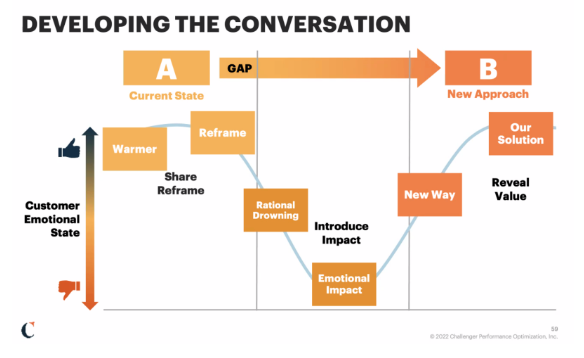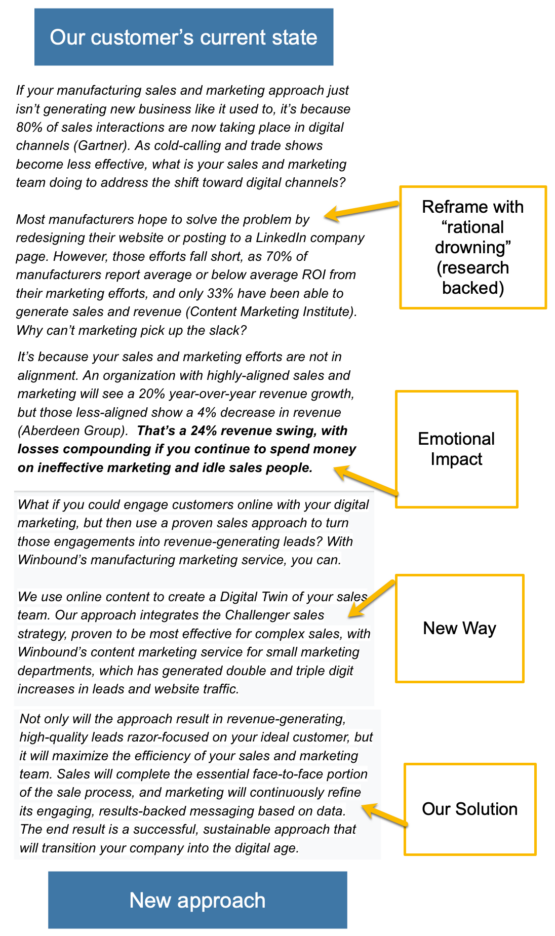I recently took my first sales training class, which made me realize how valuable an understanding of the sales process is for me as a marketer. And when it came time to create the final assignment for the class, my value to the sales team became clear as well.
The class was called “Applying the Challenger Sale.” It’s based on the book The Challenger Sale by Brent Adamson and Matthew Dixon. (Note: If you’re interested in taking the class, I have a sign-up link at the end of the article.)
If you haven’t read The Challenger Sale and you’re involved in a marketing effort for complex B2B sales, I consider it a must. It’s not only a common-sense sales strategy but also research-backed, and the data is very compelling. I had read the book, and when I saw the in-depth training, I jumped at it.
Now granted, The Challenger Sale is primarily focused on sales professionals, but the approach is very strategic and requires tremendous marketing support. I assumed I wouldn’t be the only marketer at the training. But I was wrong.
A lack of sales and marketing alignment can cost you revenue
Prior to the class beginning, we were given access to an online portal with a discussion section and asked to introduce ourselves to the group. Profile after profile revealed some high-level sales reps working with some very large companies.
As I reviewed the titles behind each name, I couldn’t help but wonder: Where the heck are all the marketers?
It made perfect sense for me to be there. Our manufacturing marketing strategy involves using online content to create a Digital Twin of your salesperson. For that to happen, sales and marketing must be aligned.

The Digital Twin strategy guide — download link at the end of this blog.
Aligning these two departments can help every organization. In fact, a lack of alignment can actually cost you revenue.
Companies with sales and marketing alignment achieved a 20% average growth (increase) in annual company revenue compared to a 4% average decrease among “laggard” organizations. (Source: Aberdeen Group)
If you want sales and marketing aligned, it all starts with strategy.
The focal point of any sales and marketing strategy
One of the biggest things I hear from companies is they need help with their sales and marketing strategy. Often strategies between the two disciplines are separated, which is fine if you’re getting down to tactics. But the overall strategy has to be cohesive.
The Challenger approach provides this cohesion by starting where all sales and marketing should start: With the customer.
The strategy requires challenging your customer’s current way of doing business. You show them why their current approach isn’t working and provide them with a new, more effective way to accomplish their goals.
This involves “reframing” their current state, revealing problems they hadn’t considered. You have to use research-backed material to explain the impact on their business (called rational drowning), as well as case studies to tie into their emotions.
A schematic of the approach looks like this:

This might seem a bit overwhelming at first glance, but the instructors walked us through it, showing us the important parts of creating a compelling sales and marketing strategy.
Then we were told to create our own Challenger sale approach. Take a look at what I developed for Winbound:

This assignment was given to me on a Thursday. I spent a lot of time researching, writing, and revising it for the class on Monday. When the big day came, I was excited to present what I wrote and hear what other people had put together. But I was in for a big surprise.
Why I heard crickets
There were over fifteen people in that Challenger class, but when it came time to present, like the brown-noser I am, I was the first to volunteer. I got a lot of valuable feedback and great suggestions, including some tremendous marketing ideas.
But when the instructor called for the next presentation, we heard only crickets.
No one else had a Challenger conversation to share.
Why?
There could be a myriad of different reasons why this occurred. Maybe some didn’t see the value in creating it. Maybe some didn’t have time. Maybe some did create it but didn’t feel confident about what they produced.
But I think it boils down to this:
- Salespeople excel at interpersonal skills and have an innate sense of how to read people. Their preferred method of communication is verbal.
- Marketing people are gifted at creative messaging and storytelling. They tend to live in their heads a bit more, and they prefer to communicate through words and pictures.
In other words, the verbal communicators were in the class without their messengers, and the work didn’t get done.
Why sales and marketing need to be in the room where it happens
In one of the breakout sessions, I spoke to a salesperson who expressed frustration at his company’s misaligned sales and marketing effort.
He felt his marketing team was spread too thin throughout the organization. They also didn’t thoroughly understand his vertical, which was reflected in their marketing material.
His story paralleled what occurred in our class. Companies had sent their sales team in for training but didn’t include marketing in the cohort. And as a result, the strategies didn’t get produced.
Whenever high-level strategy occurs, both sales and marketing need to be in the room where it happens. Because if they’re not, it’s just not going to happen.

